Re Ian Bremmer 'Could third-party candidates upend the 2024 US election?' 3 April The current political movement in the USA…
Cities & sustainability
Written by Diana Thebaud Nicholson // December 29, 2017 // Cities, Sustainable Development // 1 Comment
The Guardian A history of cities in 50 buildings
Agenda 21
Safer, Smarter and Sustainable Cities
C40 Cities Climate Leadership Group
End of the car age: how cities are outgrowing the automobile
Cities around the world are coming to the same conclusion:
they’d be better off with far fewer cars.
So what’s behind this seismic shift in our urban lifestyles? (April 2015)
Guardian Canada week
29 December
(Brookings) A defining year for cities. In many U.S. cities, events in 2017 sparked discussions about critical issues like climate change, race relations, immigration, and even the location of Amazon’s next headquarters. Read the seven most important takeaways from the year for metropolitan America here.
21 December
Jakarta Is Sinking So Fast, It Could End Up Underwater
A tsunami of human-made troubles in the Indonesian capital poses an imminent threat to the city’s survival. And it has to deal with mounting threats from climate change.
By MICHAEL KIMMELMAN, Photographs by JOSH HANER
(NYT) With climate change, the Java Sea is rising and weather here is becoming more extreme. Earlier this month another freakish storm briefly turned Jakarta’s streets into rivers and brought this vast area of nearly 30 million residents to a virtual halt.
Jakarta is sinking faster than any other big city on the planet, faster, even, than climate change is causing the sea to rise — so surreally fast that rivers sometimes flow upstream, ordinary rains regularly swamp neighborhoods and buildings slowly disappear underground, swallowed by the earth. The main cause: Jakartans are digging illegal wells, drip by drip draining the underground aquifers on which the city rests — like deflating a giant cushion underneath it. About 40 percent of Jakarta now lies below sea level.
Climate change acts here as it does elsewhere, exacerbating scores of other ills. And in Jakarta’s case, a tsunami of human-made troubles — runaway development, a near-total lack of planning, next to no sewers and only a limited network of reliable, piped-in drinking water — poses an imminent threat to the city’s survival.
13 November
 A rendering of the Floating Island Project in French Polynesia. Blue Frontiers will build and operate the islands, with the goal of building about a dozen by 2020, including homes, hotels, offices and restaurants, at a cost of about $60 million. Credit Blue Frontiers
A rendering of the Floating Island Project in French Polynesia. Blue Frontiers will build and operate the islands, with the goal of building about a dozen by 2020, including homes, hotels, offices and restaurants, at a cost of about $60 million. Credit Blue Frontiers
Floating Cities, No Longer Science Fiction, Begin to Take Shape
“If you could have a floating city, it would essentially be a start-up country,” said Joe Quirk, president of the Seasteading Institute. “We can create a huge diversity of governments for a huge diversity of people.”
(NYT) It is an idea at once audacious and simplistic, a seeming impossibility that is now technologically within reach: cities floating in international waters — independent, self-sustaining nation states at sea.
Long the stuff of science fiction, so-called “seasteading” has in recent years matured from pure fantasy into something approaching reality, and there are now companies, academics, architects and even a government working together on a prototype by 2020.
At the center of the effort is the Seasteading Institute, a nonprofit organization based in San Francisco. Founded in 2008, the group has spent about a decade trying to convince the public that seasteading is not an entirely crazy idea. … over the years, the core idea behind seasteading — that a floating city in international waters might give people a chance to redesign society and government — steadily attracted more adherents. …
Even if the Seasteading Institute is able to start a handful of sustainable structures, there’s no guarantee that a utopian community will flourish. People fight about much more than land, of course, and pirates have emerged as a menace in certain regions. And though maritime law suggests that seasteading may have a sound legal basis, it is impossible to know how real governments might respond to new neighbors floating offshore.
Mr. Quirk and his team are focusing on their Floating Island Project in French Polynesia. The government is creating what is effectively a special economic zone for the Seasteading Institute to experiment in and has offered 100 acres of beachfront where the group can operate.
3 November
From Miami to Shanghai: 3C of warming will leave world cities below sea level
An elevated level of climate change would lock in irreversible sea-level rises affecting hundreds of millions of people, Guardian data analysis shows
(The Guardian) At six of the coastal regions most likely to be affected, government planners are only slowly coming to grips with the enormity of the task ahead – and in some cases have done nothing.
This comes ahead of the latest round of climate talks in Bonn next week, when negotiators will work on ways to monitor, fund and ratchet up national commitments to cut CO2 so that temperatures can rise on a safer path of between 1.5 and 2C, which is the goal of the Paris agreement reached in 2015.
The momentum for change is currently too slow, according to the UN Environment Programme. In its annual emissions gap report, released on Tuesday, the international body said government commitments were only a third of what was needed. Non-state actors such as cities, companies and citizens can only partly fill this void, which leaves warming on course to rise to 3C or beyond by the end of this century, the report said.
1 November
Better Planning, Better Cities
(World Bank) The Global Platform for Sustainable Cities, or GPSC, announced an important development during their 2nd annual conference this week: India is establishing its own platform for sustainable cities, to mirror the expanding initiative.
India’s announcement at the conference – attended by 200 mayors and other municipal officials, academics, and business leaders – marks significant progress for the platform, established only last year in Singapore.
Supported by the Global Environment Facility and managed by the World Bank, the GPSC serves as a connector of cities working towards more integrated urban planning, more use of renewable energy, and more efficient delivery of services. It supports its 27 partner cities in developing action plans that will improve their fiscal sustainability and lead to investment grade creditworthiness, as well as assist in leveraging existing resources and exploring options, such as long-term debt financing, PPPs, and land value capture mechanisms structured with appropriate credit enhancements.
The forum also launched the GPSC’s Urban Sustainability Framework (USF), which provides guidance for cities on how to prepare and implement their action plans. The USF includes Sustainability Indicators which are benchmarked regionally and globally, a Diagnostic Process that utilizes growth-scenario modelling and analysis that will enable the prioritization of infrastructure investments, and action plans that integrate sustainability from conception.
“City leaders can customize the Urban Sustainable Framework to identify the policy options that are most politically, technically, and fiscally feasible, to invest in cities that are more resilient to climate change and embody urban management that is both participatory and inclusive,” said Xueman Wang, Senior Urban Specialist and coordinator for the GPSC.
5 September
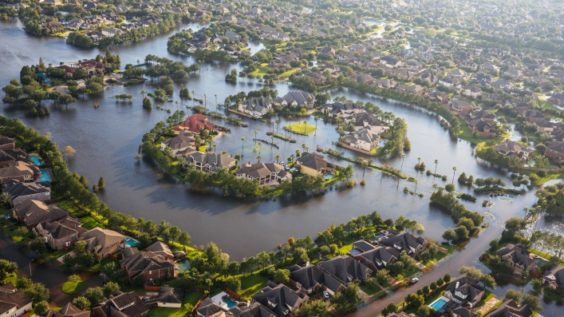
[Photo: Marcus Yam/Los Angeles Times/Getty Images]
The Cities Of The 21st Century Will Be Defined By Water
“If we only respond to the past, we will only get answers that fit the past,” says Dutch water expert Henk Ovink.
(Co. Design) Now, as cities wrestle with the reality of more intense storms, more flooding, and more water to manage, low-impact development is earning renewed recognition as an essential mechanism to help them become more resilient. It’s emblematic of a broader philosophical shift in how architects, engineers, and planners think about water: as a resource to live with, instead of pushing away. And as Houston begins to recover, experts are pushing for the city–and others–to adopt the same ethos.
31 August
The US cities at risk of flooding – and how they deal with it
Rising sea levels pose a serious threat to cites like Boston, New York and Miami Beach. So what are they doing to protect themselves?
(The Guardian) Cities, by their very nature, struggle during flood situations. Water that would have been soaked up by grass and other vegetation washes off the concrete and asphalt of urban areas and, if not properly diverted away, can inundate homes.
Harvey brought a huge amount of rainfall, but cities now face flooding threats even without a major storm. “Rare events are going to become more common in the future strictly due to sea level rise,” said William Sweet, an oceanographer at the National Oceanic and Atmospheric Administration (Noaa).
“We are already seeing flooding in property and the streets in Charleston, Norfolk and Miami on sunny days, driven by the tides. That is a looming crisis that is only going to grow more severe over time.”
… there is no easy solution – a sea wall simply pushes the water elsewhere … The water has to go somewhere and decades of development on flood-prone land has left little space to maneuver for some municipalities.
“There are coastal cities at risk from an extreme event and they have giant sea walls or houses on stilts,” said Sweet. “But then there are communities that don’t face a big hurricane threat but water is bubbling up from underneath them. They can’t defend against this sort of flooding. You can’t build a wall everywhere.”
Some progressive cities have started to look at alternative approaches, most notably from the Netherlands, where communities “live” with the water, allowing certain areas to flood while aggressively defending critical infrastructure. Natural sponges such as parklands, wetlands and dunes are now also in vogue with city planners.
But as attitudes to flooding slowly shift, the problem is escalating. Scientists are now confident that hurricanes will become more powerful, fed by a warming, moisture-laden atmosphere, while more common “nuisance” flooding will become so frequent along parts of the US east coast that they will occur once every three days by 2045. By around this time, a majority of US coastal areas are likely to be threatened by 30 or more days of flooding each year.
30 August
A Storm Forces Houston, the Limitless City, to Consider Its Limits
(NYT) Two years ago, Erin Kinney, a research scientist with the nonprofit Houston Advanced Research Center, wrote that 65 square miles of freshwater wetlands had been lost in the Houston-Galveston Bay region, largely because of development and sinking land, and that 30 percent of Harris County was covered with impervious surfaces like roads, parking lots and roofs.
Much of the development in recent years has occurred on the Katy Prairie, a vast stretch of land west of town that was once covered in native grasses and wildflowers, a place where rainwater often pooled before soaking into the ground or slowly running into creeks and bayous.
Gavin Smith, the director of the Coastal Resilience Center at the University of North Carolina at Chapel Hill, said some of the land in the Houston area had been made more vulnerable to flooding because of the amount of groundwater that had been pumped out of it. That, he said, actually caused the land to sink, a process called subsidence.
27 August
Houston Wasn’t Built for a Storm Like This. It won’t be next time either.
(Slate) One underlying cause of Houston’s suffering is that developers and town officials in Harris County, which contains Houston, have for years advocated the development of the wetlands and prairies around the city—land that had long served to absorb the rainwater that now overwhelms the region’s sewers and streams every year. The flood-absorbent grasslands of the Katy Prairie have been cut by three-quarters over the past few decades as Houston sprawled west. The state played along, funding expansion of I-10, “the Katy Freeway,” and another road, the Grand Parkway, which further opened that land up for development. To make matters worse, money-hungry officials also encouraged development in low-lying, flood-prone areas without regard to future risk. There have been more than 7,000 units built in the hundred-year floodplain since 2010, according to a ProPublica/Texas Tribune analysis. Efforts to reform the city’s building codes have been met with strong resistance in an area where homebuilding has been a major economic engine.
3 August
 Trees to grow on the balconies of Penda’s timber high-rise in Toronto
Trees to grow on the balconies of Penda’s timber high-rise in Toronto
(Inhabitat) A new kind of “vertical forest” has been envisioned for Toronto where trees would grow on every balcony. Architecture firm Penda teamed up with Canadian company Timber to design the Toronto Tree Tower, an 18-story mixed-use tower covered in greenery and built of cross-laminated timber. The large and modular balconies are staggered to look like branches of a tree and to optimize views for every resident.
Designed to appear as a giant tree in the city, the Toronto Tree Tower is covered in plants and greenery and clad in wooden facade panels. The tower’s modular cross-laminated timber units would be prefabricated and assembled off-site, and then transported and stacked around the building’s trunk-like central core. The building would comprise 4,500 square meters of apartments as well as a cafe, children’s daycare center, and community workshops.
30 June
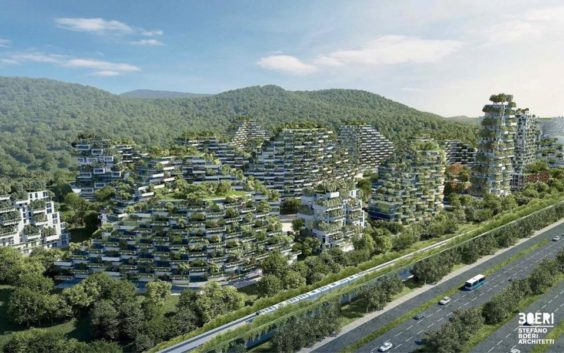
China’s New ‘Forest City’ Will Make You Rethink Urban Cities
(Forbes) a “Forest City” that pushes the boundaries of sustainable urban planning and development.
The Chinese government has broken ground on this Forest City with the ambitious plan to have it fully completed by 2020, an urban development that will be covered in plants and solar panels. The city will sit along the Liujiang River in the mountainous region of Guangxi in southern China.
A key premise for this Forest City will be to fight air pollution that has engulfed many of China’s metropolitan areas and remains a critical health threat to the Chinese people.
The city will include typical buildings such as schools, offices, hotels, hospitals, and homes of course. Albeit, these will all be covered in thousands of trees and plants of various species.
The abundance of plants will improve many aspects of the city such as air quality and pollution. A few key side benefits include a lower average air temperature, improved biodiversity of plants and animals in the area, noise barriers, and an ecosystem for birds and insects.
The Forest City will also boast geothermal energy for air conditioning of the buildings and solar panels on roofs to supplement. To get around the residents will be able to use an electric rail line that goes through the center of the city in addition to electric cars.This ambitious plan will be an example to the global community on how to build sustainable cities that help cut down on pollution while at the same time generate biodiversity and fresh oxygen.
This concept may not work exactly as built here for every city but there are certainly ideas and best practices that can be implemented around the world. This is especially true in highly populated polluted areas that are badly in need of more green space.
In a much lighter vein
‘Places you’ll only visit due to random misfortune’: an alt guide to Canada’s cities
Canada Day 2017 is also the country’s 150th birthday. To mark this special occasion, we present this handy guide to its biggest urban centres, as found in The CANADALAND Guide to Canada
28 May
This Town’s Walmart Was ABANDONED.
After the store shuttered, it eventually fell into the property of the city, and the decision was made to turn the building into a public library.
The redesign was a smashing success among designers. It won the 2012 Library Interior Design Competition held by the International Interior Design Association.
The remodel was also a success for the library’s business. Membership increased by 23 percent the year it opened.
12 May
World’s largest vertical garden blooms with 85,000 plants in the heart of Bogota
(Inhabitat) The largest vertical garden in the world. Located in Bogota, Colombia, the Santalaia building is completely covered with a lush layer of 85,000 plants that span 3,100 square meters (33,368 square feet). A vertical garden of this size can produce enough oxygen for more than 3,100 people every year, process 1,708 pounds of heavy metals, filter more than 2,000 tons of harmful gases and catch more than 881 pounds of dust. (with slideshow)
12 April
The hype about China’s newest city
Rather than creating a new city, it might be cheaper and more efficient to improve Beijing’s design and infrastructure. More subway lines, denser neighbourhoods and better water conservation are all needed. Upgraded transport links to nearby cities would also help. But China has the political will and the financial muscle to start afresh and build a city from the ground up. Next stop: Xiongan.
(The Economist) When the government announced on April 1st that it would create “Xiongan New Area” as a metropolis from scratch, it immediately set off a frenzy. Housing prices in the zone, about 100km (62 miles) south-west of Beijing, more than tripled overnight before authorities ordered a halt to property transactions. Local hotels were booked up and roads packed with cars as prospective investors flocked to what is still largely farmland. The shares of companies such as local cement-makers and real-estate developers soared in value. State media extolled the promise of the city, touting it as a new chapter in China’s urban development. What is all the fuss about?
The government’s intention is to make Xiongan an annex of Beijing, to take pressure off the Chinese capital, which is struggling to cope with a population of more than 20m people. Beijing’s traffic jams are horrendous, its subways overloaded and its water supply running low. In recent years planners have encouraged people to move away from the centre, to suburbs and nearby cities. The creation of Xiongan marks an escalation in these efforts: China wants to make it a model city, with a clean environment, fast transport and high-tech industries, to attract millions of people. The hope is that a big slice of Beijing’s “non-capital functions”, from businesses to universities, will move to Xiongan. Initially, it will cover 100 sq km, nearly twice the size of Manhattan. Eventually, the aim is to reach 2,000 sq km, more than twice as big as New York city or Singapore.
6 April
Craig and Marc Kielburger: How To Build Resilient Cities In The Face Of Natural Disaster
(HuffPost) Resilience is the ability to rebound from hardships and setbacks, often associated with workers, athletes or young children.
But resilience applies as much to cities as it does to individuals, especially with the growing threat of climate change. Weather-related disasters have increased by 14 per cent globally over the past 20 years. Municipalities must be prepared to face and overcome threats like flooding, or the 2016 Alberta wildfires.
Four Canadian cities — Calgary, Montreal, Toronto and Vancouver — have joined an innovative global project designed to strengthen the world’s metropolises.
Launched by the Rockefeller Foundation, 100 Resilient Cities helps urban centres work with other governments and community groups, and learn from cities around the world to identify potential threats and prepare for them. Participating cities receive funding to create a high-level Chief Resiliency Officer role in their governments. They also have access to an estimated US$400 million in services–consulting, research, and engineering assistance–donated by companies around the world.
We spoke to city officials in Toronto, Vancouver and Montreal about the biggest threats they foresee. Toronto cites extreme weather, such as heat waves and ice storms. Vancouver leaders fret about rising sea levels, as well the ever-present fear of a major earthquake. Montreal is concerned with crumbling infrastructure, with its old roads and bridges.
In particular, Canada’s biggest cities are thinking about how these challenges might affect their most vulnerable citizens.
27 January
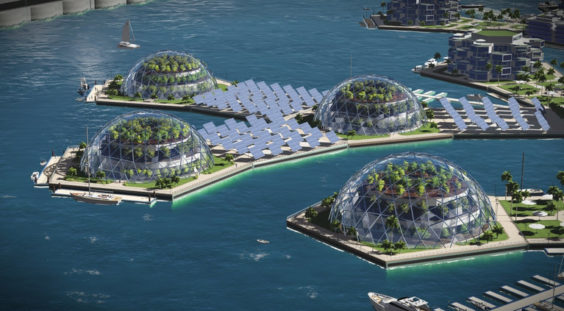 A rendering of the artificial floating island project in French Polynesia. The project is being put forward by a California nonprofit, the Seasteading Institute, which has raised about $2.5 million from more than 1,000 interested donors. Credit Seasteading Institute
A rendering of the artificial floating island project in French Polynesia. The project is being put forward by a California nonprofit, the Seasteading Institute, which has raised about $2.5 million from more than 1,000 interested donors. Credit Seasteading Institute
As Climate Change Accelerates, Floating Cities Look Like Less of a Pipe Dream
You might call it a Noah’s Ark for an era of melting polar ice sheets.
An audacious plan to respond to climate change by building a city of floating islands in the South Pacific is moving forward, with the government of French Polynesia agreeing to consider hosting the islands in a tropical lagoon.
The project is being put forward by a California nonprofit, the Seasteading Institute, which has raised about $2.5 million from more than 1,000 interested donors. Randolph Hencken, the group’s executive director, said work on the project could start in French Polynesia as early as next year, pending the results of some environmental and economic feasibility studies.
“We have a vision that we’re going to create an industry that provides floating islands to people who are threatened by rising sea levels,” Mr. Hencken said.
The group’s original founders included Peter Thiel, a billionaire investor and prominent supporter of President Trump, although Mr. Thiel is no longer donating to the institute, Mr. Hencken said.
2016
19 December
The Smartest Cities Are Compassionate Cities
The case for a new core operating tenet for local governments.
(CityLab) A city government exists to provide services to its citizens, though it may not feel that way after spending an afternoon applying for a construction permit. Paper-driven, anachronistic processes continue to paint local governments in a negative light, making citizens’ lives more frustrating. What if cities had compassion for their citizens and approached providing services with user empathy? Existing mechanical processes such as obtaining a small business license or contesting a parking ticket are ripe for a revolution.
When cities put a priority on creating a great experience for every interaction, they become more compassionate and accessible in the process.
What might happen if compassion were a core operating tenet of local governments? It would be an unorthodox approach to think of citizens as customers, tenaciously working to ensure they do not lose them to a competitor (i.e., moving to another city). But with this mindset, city leaders would be required to truly understand and empathize with their customers. A customer-focused city would deliver solutions that make lives better.
Las Vegas’s city government is now powered by 100% renewable energy, and more cities will follow
(Quartz) Ten years of effort finally paid off for Las Vegas this week when officials announced the city government will now be powered entirely by renewable energy. After a large solar array, Boulder Solar 1, came online on Dec. 12, the city was able to buy enough carbon-free electricity to power its 140 buildings, streetlights and other facilities. The power flows from a mix of solar panels and hydroelectric turbines including the Hoover Dam. The renewables, plus energy efficiency savings, are estimated to save the city roughly $5 million per year, reports the Las Vegas Review-Journal. Las Vegas is one of many cities pushing ahead with aggressive efforts to leave fossil fuels behind.
7 December
How the U.S. Postal Service could enable smart cities
The USPS fleet in the field could be enabled with sensors that serve as the eyes and ears of smart cities to improve services. But hurdles abound.
(ZD Net) Here’s the gist of how the USPS could be a smart city enabler:
Trucks and assets drive through cities everyday.
These assets could monitor conditions and the environment for things like potholes, potential for blight and infrastructure conditions.
Data could be delivered back to cities to enhance services.
This data enablement could be a new revenue stream assuming that the Postal Service would be allowed to expand into new services. Regulations prevent the Postal Service from entering non-postal businesses.
5 December
Remember Louisiana’s devastating floods in August? Expect to see more like it across the U.S. as climate change marches on. A new map from the National Center for Atmospheric Research shows which regions are in for the most extreme changes by the end of the century.
The 2016 C40 Mayors Summit
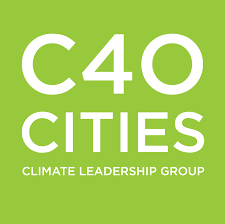 C40 Mayors, city representatives, and hundreds of urban and sustainability leaders are gathering in Mexico City for the sixth biennial C40 Mayors Summit, 30 November – 2 December 2016. The Summit is advancing urban solutions to climate change and highlighting the leadership role of cities in addressing climate change and implementing the Paris agreement
C40 Mayors, city representatives, and hundreds of urban and sustainability leaders are gathering in Mexico City for the sixth biennial C40 Mayors Summit, 30 November – 2 December 2016. The Summit is advancing urban solutions to climate change and highlighting the leadership role of cities in addressing climate change and implementing the Paris agreement
Four of world’s biggest cities to ban diesel cars from their centres
Paris, Madrid, Athens and Mexico City will ban the most polluting cars and vans by 2025 to tackle air pollution
The mayors of Paris, Madrid, Athens and Mexico City announced plans on Friday to take diesel cars and vans off their roads by 2025.
Anne Hidalgo, mayor of Paris, led the initiative at the C40 conference of mayors on climate change, taking place in Mexico this week. She said: “Mayors have already stood up to say that climate change is one of the greatest challenges we face. Today, we also stand up to say we no longer tolerate air pollution and the health problems and deaths it causes, particularly for our most vulnerable citizens.”
30 November
Cities and States Lead on Climate Change
By Jeff Biggers, the author of “Reckoning at Eagle Creek: The Secret Legacy of Coal in the Heartland,” founder of the Climate Narrative Project at the University of Iowa
(NYT op-ed) As President-elect Donald J. Trump considers whether to break the United States commitment to the Paris climate accord, the rise of clean energy across the heartland is already too well entrenched to be reversed.
By 2020, thanks to MidAmerican Energy’s planned $3.6 billion addition to its enormous wind turbine operations, 85 percent of its Iowa customers will be electrified by clean energy. Meanwhile, Moxie Solar, named the fastest-growing local business by The Corridor Business Journal of Iowa, is installing solar panels on my house, and is part of a solar industry that now employs 200,000 nationwide.
Doomsday scenarios about the climate have abounded in the aftermath of the November election. But responsibility for effectively reining in carbon emissions also rests with business, and with the nation’s cities and states. Those are the battlegrounds. Worldwide, cities produce as much as 70 percent of greenhouse gas emissions.
Many of the planet’s cities lie along the coasts and are threatened by slowly rising seas. Seventy percent of those cities are already dealing with extreme weather like drought and flooding. Add in aging infrastructure and waves of migrants and it is obvious that city planners, mayors and governors have had to re-envision how their cities generate energy and provide food and transportation.
31 October
Globally, Sprawl Is Getting Worse
(Aspen Institute) By 2050, an expected 2.5 billion people around the world will be moving to cities. And these numbers don’t even account for the impending migration of communities who are most at risk from climate change. The question of what form and shape global cities will take to absorb future residents was at the heart of a presentation by Ricky Burdett, the director of LSE Cities, at The Atlantic’s CityLab 2016 summit in Miami.
So far, the picture looks bleak. Between 1990 and 2050, average population growth in 200 cities around the world is expected to reach 300 percent. But the average footprint—the actual physical form of the city—will expand by nearly 500 percent. “Which means that density is dropping,” Burdett said. “In terms of environmental sustainability, that’s aptly critical.”
Around 90 percent of this new urban growth will be concentrated in Asia and Africa, regions where informal structures are already a staple in big and small cities alike. That’s where the need for smart growth interventions is the greatest, says Burdett. India’s Smart Cities Challenge is one high-profile example of an innovative approach. In it, over 100 Indian cities have submitted proposals aimed at tackling municipal problems, hoping to win a slice of an expected $15 billion total to eventually implement their plans. Twenty proposals have been awarded funding so far.
Whether or not India’s cities will be adequately prepared for the future remains to be seen. But what’s significant is that urban development is now being regarded as a priority in that country, and possible solutions are being considered in a thoughtful, thorough manner. That’s the first step to correcting course for cities around the world.
6 October
Most cities see climate action as an economic opportunity
(EurActiv) 190 cities around the world have already taken action to reduce their greenhouse gas emissions, according to the annual Carbon Disclosure Project (CDP), published on Tuesday (4 October). EurActiv’s partner Journal de l’Environnement reports.
This report, based on the volontary declarations of 533 municipalities in 2016, shows that North America (74) and Europe (72) are home to the vast majority of these pro-active cities. But Asia (29), Latin America (six) and Africa (three) are all making efforts.
Between them, these municipalities identified 2,000 concrete effects that climate change was having on their territory, including flooding, extreme temperatures and water shortages.
Among the pioneers of climate action, Stockholm has committed to reducing its greenhouse gas emissions by the equivalent of 3.2 tonnes of CO2 per inhabitant by 2020, and to be completely free of fossil fuels by 2040.
Across the Atlantic, New York has also committed to cutting its emissions by 80% by 2050, compared to 2005 levels. To achieve this, the city aims to make a 30% reduction in emissions from its buildings by 2025 thanks to energy efficiency renovation.
28 July
 Heavy rains spare ancient Forbidden City, flood modern skyscrapers
Heavy rains spare ancient Forbidden City, flood modern skyscrapers
(Asia News) Built 600 years ago, the imperial palace has a drainage system that works better than modern ones. Despite weeks of pounding rains across China, hundreds of “water spitting” dragon-shaped drainage points in the Forbidden City release excess water and prevent flooding. Online humour stresses how “modern drainage systems can’t even beat the ancient ones that were erected six centuries ago!”
After weeks of floods across China, only one place seems safe and dry, the Forbidden City.
8 July
Calgary versus the car: the city that declared war on urban sprawl
Calgary is like any other Canadian city that grew outwards, not upwards. But led by progressive mayor Naheed Nenshi, the oil-rich, car-friendly city has become an unlikely leader in the battle to limit urban sprawl
Every Canadian city now wrestles with the outsized cost of providing access to those increasingly distant suburbs. Freeways grow ever-more clogged with traffic, and infrastructure bends and cracks under the strain. In Toronto, a pitched battle has been fought over the future of an elevated waterfront highway, leading to a compromise that pleases almost no one.
[Mayor Nenshi’s] appetite for wading into the trenches of municipal legislation has made Calgary a surprising pacesetter in Canada’s battle against sprawl. A year ago this month, the city created a downtown network of separated cycle tracks. The three-mile system is a poor cousin of Copenhagen’s or Amsterdam’s, and not yet equal to Montreal’s, but it’s as significant a commitment to cycling as in any other Canadian city. …
Inner-city neighbourhoods, meanwhile, are densifying at a rate not seen in decades. And if too much of the city’s new housing is still built on curvilinear suburban streets at the city’s rim, the centre of gravity has shifted substantially away from business as usual.
17 May
Cities ‘woefully unprepared’ for rising disaster risk, World Bank says
(Reuters via CBC) Cities around the world are failing to plan for fast-increasing risks from extreme weather and other hazards, particularly as population growth and surging migration put more people in the path of those threats, the World Bank said on Monday.
By 2050, 1.3 billion people and $158 trillion in assets will be menaced by worsening river and coastal floods alone, warned a new report from the Global Facility for Disaster Reduction and Recovery (GFDRR), managed by the World Bank.
“Cities and coastal areas are woefully unprepared for the kind of climate and disaster risk now facing our world,” said John Roome, the World Bank Group’s senior director for climate change.
12 May
Air pollution rising at an ‘alarming rate’ in world’s cities
Outdoor air pollution has grown 8% globally in the past five years, with billions of people around the world now exposed to dangerous air, according to new data from more than 3,000 cities compiled by the World Health Organisation (WHO). While all regions are affected, fast-growing cities in the Middle East, south-east Asia and the western Pacific are the most impacted with many showing pollution levels at five to 10 times above WHO recommended levels.
29 February
Five of the best water-smart cities in the developing world
We round up some of the most interesting urban projects to manage, protect and conserve water supply
(The Guardian) With the majority of the world’s population now living in cities, solving water problems specific to metropolitan areas is crucial. Whether there’s too much water or not enough, whether it’s too polluted or too salty, these issues can be solved with thought, ingenuity, money and organisation. Here are some innovative ways cities are managing, protecting and conserving water supplies.
18 February
How cities you’ve never heard of will shape the future
By: Robert Muggah. Research Director of the Igarapé Institute and Director of Research and Policy at the SecDev Foundation
The future of global security and development will be determined by our cities. Yet, understanding their fragility is an ongoing challenge.
(Open Canada) All cities are fragile. The intensity of their fragility, however, varies considerably across time and space. Some cities – Aleppo, Caracas, Kabul, or Mogadishu – are affected by acute fragility and are close to collapse. Others – Abuja, Baltimore, Dhaka, and San Salvador – are also at risk, albeit to lesser degree. Even cities like Amsterdam, London, New York, Paris, and Tokyo are not immune.
Fragility occurs when city authorities are unable or unwilling to deliver basic services to citizens. It is triggered by a rupture of a city’s social contract, when citizens lose confidence in the legitimacy of municipal institutions. So what tips cities over? The intensity of fragility is conditioned by an accumulation of risks. And some risks – the pace of urbanization, income and social inequality, youth unemployment, homicidal and criminal violence, poor access to key services, and exposure to climate threats – are more serious than others.
Today’s debate on cities is limited to the world´s 30-odd megacities and the 600 cities driving international economic growth. They’ve expanded with dizzying speed: these cities constitute a new layer of global governance. Yet there is virtually no discussion about what is happening in the other roughly 3,400 cities with over 100,000 residents. And there is a veritable silence about the other 50,000 cities and urban localities around the world. This is worrying because it is cities whose names you’ve never heard of that will shape the future.
11 February
There’s A Lesson In Spain’s Surreal, Unfinished Cities
The financial crisis left scores of abandoned development projects and showed the consequences of “speculative urbanization.”
(World Post) … in Spain, where there were more than 3 million unoccupied homes in 2014 half-finished developments still dot the landscape.
They’re the subject of The City That Never Was, a book published in January by Christopher Marcinkoski that investigates what he calls “speculative urbanization.” He uses the term to describe what happens when public and private groups embark on large development projects for an economic boost rather than actual need, and shows the devastating consequences.
“A lot of the infrastructural building ended up being more about nation building than it was about long-term, sustainable planning and building logic, … and that led, in my mind, a great deal to the housing glut that was produced,” Marcinkoski said.
14 January
Nenshi: We’re finally going to stop subsidizing sprawl
(Calgary Herald) When a new community is built, the developer pays for the infrastructure that is specific to that community. This includes the roads, street lights, water and sewer systems (among other things) inside the community. Most developers pass these infrastructure costs along to the homebuyer, which essentially results in residents paying for the community in which they live. People who live in other parts of the city are not affected by these costs.
However, each new community or development has an impact on infrastructure outside of its specific borders — causing more demand on things like major bridges and interchanges leading into and out of the neighbourhood, wastewater lift stations, wet and dry ponds, and traffic signals on major roadways. For many years, all Calgary taxpayers, regardless of whether or not they were directly affected by the development, bore the cost of growth on much of this off-site infrastructure, and these costs were distributed among all taxpayers.
All Calgarians continued to subsidize the development of new suburban communities. In 2012, this subsidy cost Calgarians approximately $33 million annually in lost revenue. That’s why I based a large part of my 2013 re-election campaign on this very issue.
For the last year, many people have worked hard to create a new method of calculating off-site levies to ensure that we can keep up with the costs of serving all of our new citizens. City administration collaborated with industry to find a process that was fair to everyone — especially all citizens. And on Monday, council unanimously passed these changes.
8 January
Paris’ Monumental Suburban Housing Projects Challenge Ideas About How the French Live
(Slate) Since 2011, French photographer Laurent Kronental has been working on an ongoing series documenting life on the edge of Paris in the “grands ensembles.” These monumental housing projects were built between the 1950s and the 1980s on the outskirts of major French cities as answers to a dearth of housing and an influx of foreign migrants. Aging monolithic concrete structures with an almost alien presence in the French landscape, they are a far cry from the Haussmannian apartment blocks that dominate central Paris and the world’s collective imagination about how the French live
2015
8 December
Can Miami Beach Survive Global Warming?
(Vanity Fair) Miami real estate is booming as never before—but rising sea levels driven by global warming might mean a major bust. The mayor, climate scientists, and other experts tackle the dilemma.
Compounding the city’s vulnerability to major weather events is the worldwide phenomenon of sea-level rise. Due to thermal expansion of the oceans and the melting of ice sheets and glaciers in the Earth’s far latitudes, the global mean sea level is rising. How fast and how much is a matter of debate, with such federal agencies as the U.S. Army Corps of Engineers, NASA, and the National Oceanic and Atmospheric Administration projecting, on the low end, eight inches of sea-level rise by the year 2100, and, on the high end, as much as six feet.
But Miami Beach, a low-lying city to begin with, is already feeling the effects of sea-level rise. Every time there’s a heavy rain, the locals brace for flooding on Alton Road, the main north-south thoroughfare of the city’s west side. On top of all this, Miami Beach must contend with a fairly new phenomenon that has come to be known locally as sunny-day flooding … a consequence of southeast Florida’s geology. … Miami Beach and its neighboring towns sit upon a foundation of porous limestone. When the tides are at or nearing their seasonal highs—the highest, which occur in March and October, are known as king tides—seawater surges inward from the bay and the ocean, bubbling up through the limestone and infiltrating the sewer system. …
While there is consensus in the scientific community that sea-level rise is accelerating, there is a startlingly broad divide in opinion on how severely and quickly it is going to affect us. [Harold Wanless, chairman of the Department of Geological Sciences at the University of Miami] stands with James Hansen on the more pessimistic end of the spectrum. In July, the 74-year-old Hansen, who was NASA’s leading climatologist until he retired from the agency, two years ago, published an alarming (albeit not yet peer-reviewed) paper in which he, along with 16 co-authors, asserts that “multi-meter sea-level rise” is “likely to occur this century” unless carbon-dioxide emissions are drastically and quickly curbed. This would spell the demise not only of Miami Beach but also of the rest of the world’s coastal cities: New York, Boston, New Orleans, Osaka, Mumbai—you name it.
4 December
Here’s How Municipalities Can Reach Their Sustainability Goals
In the past, a municipality’s fees, service charges and taxes have been seen primarily as revenue-generating tools. In reality, they also have strong incentive effects for a municipality’s environmental performance.
For example, a municipality could design development cost charges to encourage density or urban green infrastructure. Municipalities could also introduce new charges such as bag tags for garbage disposal, or storm water user fees.
MBIs may be used to support a municipalities’ other objectives across a range of important sectors, including transportation, water, air quality, and land use, among others.
Bringing effective price signals into local sustainability strategies also complements and reinforces other municipal priorities. It will lead to a more economically efficient use of urban services, reduce demand for new infrastructure spending, and diversify or possibly amplify revenue sources.
Market-based instruments are a valuable tool that may be used by communities of all sizes to close the gap between policy ambition and implementation. They are an effective way to help municipalities meet the goals outlined in their sustainability plans.
For more information on how municipal decision makers can reach their sustainability goals, please read the “Sustainability Alignment Manual”
How Mayors From Seattle to Shenzhen Lead on Pollution
(Bloomberg) Cities including Seattle, Copenhagen and Tokyo are taking the lead in slashing fossil-fuel emissions, picking up the baton from national governments that have squabbled for more than two decades over how to fight climate change.
Urban areas contain about half the world’s population now and will have two-thirds by 2050, according to the UN. That makes them “fundamental” to tackling global warming, said Rachel Kyte, the World Bank’s special envoy on climate. The measures they’re adopting range from electrifying buses, to making cycle paths and requiring more efficient buildings. Prosaic as they seem, those individual efforts are making a dent in global greenhouse gas pollution. More than 600 towns, cities and regional authorities that are home to 553 million people have committed to reducing their emissions by a total of 1 billion tons by 2020, according to ICLEI, a global network of cities and towns. That’s almost as much as Japan produces each year. …
“Cities are centers of adaptation and innovation, and they don’t have to wait
for international negotiations or congressional action,” Shelley Poticha, director of urban solutions at the Natural Resources Defense Council in Washington, said in an e-mailed reply to questions. “When cities get it right, which they increasingly are learning to do, they advance solutions that larger and even more complex entities like national governments can adopt.”
12 November
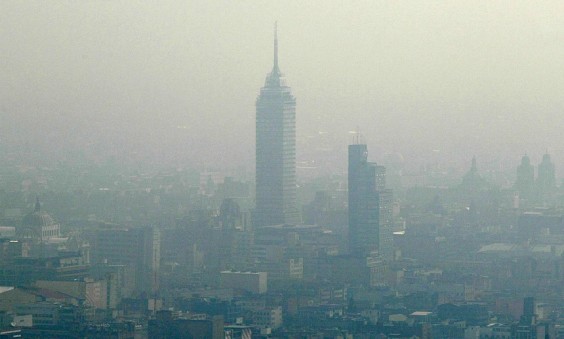 Cities must take lead role in tackling climate change, says Mexico City mayor
Cities must take lead role in tackling climate change, says Mexico City mayor
Ahead of the Paris climate talks, Mancera says countries should change direction and look to cities for inspiration – while revealing plans for a new water fund to address his city’s major shortages
Once notorious for air pollution, Mexico City’s ability to clean its skies has shown it can also be a leader in reducing emissions of greenhouse gases, according to the city’s mayor, Miguel Angel Mancera.
Speaking at the signing of a new pledge to commit the equivalent of 10% of the city’s discretionary budget to “defined resilience goals” – many of which are environment-related – Mancera stressed the role that megacities will have to play in tackling global warming.
At the upcoming UN Climate Change Conference in Paris – where national negotiators will try to put in place a new deal to slow the pace of global warming – Mexico City will join the C40 group of megacities in promoting cuts in CO2, managing waste more efficiently, and making better use of water resources.
26 October
Mayors Nenshi and Iveson on “Cities and the Future of Canada” (video)
On Wednesday, October 21, Mayor Naheed Nenshi and Edmonton Mayor Don Iveson shared the stage at the 10th Annual Hurtig Lecture on the Future of Canada. Each mayor was given 15 minutes to speak about the role of cities in our collective future, and then the two answered questions from the floor with a very engaged audience.
10 October
What Makes a Sustainable City?
(World Bank Group) A discussion with government leaders about how to support cities in becoming more socially, environmentally, and fiscally sustainable.
With most of the global population and capital goods now concentrated in urban areas, cities are key to social development and economic prosperity. Urbanization, globalization, and climate change are interacting in a way that is unprecedented, and urban service delivery systems are becoming increasingly interlinked. This session explores the challenges and innovative approaches across multiple dimensions of sustainability at the city level – economic, environmental and social – and how they contribute to shared prosperity.
What Makes a Sustainable City? A Sampling of Global Case Studies Highlighting Innovative Approaches to Sustainability in Urban Areas .pdf
22 September
China’s eco-cities are often neither ecologically friendly, nor functional cities
(Reuters blog) China’s track record with building eco-cities is spotty at best. Some end as failed construction projects. Others don’t live up to their eco-labeling after construction is completed. It has been estimated that only one in five of China’s eco-cities “actually match low-carbon or ecological ideals,” according to Li Xun, secretary of the Chinese Society for Urban Studies. Bianca Bosker, the author of Original Copies, a book about China’s Western copycat towns, calls eco-cities “the same sprawling McMansions under a different name.”
Dongtan, China’s original eco-city, was heralded as the future of urban life when it was first proposed in 2005. Instead, it ended up being “a masterpiece of greenwashing,” according to Paul French of Ethical Corporation, a corporate responsibility magazine. The original plan called for a new, energy-efficient city for 50,000 people on Shanghai’s last wetlands — a tinge of irony that was not lost on environmentalists and academics who spoke out against it at the time. In the end, no wetlands were hurt as the place was never built. This city of the future became a small array of face-saving conventional high-rises masquerading as “green” and a wind farm.
The ecological benefits of Nanhui, an eco-city with a unique circular street pattern built on land reclaimed from the sea roughly 35 miles outside of Shanghai, are also not evident. For purposes of self-aggrandizement and marketing, local government officials wanted the artificial lake at the city’s center to be larger than Hangzhou’s famous West Lake. So the original design was amended and its scale was expanded to accommodate the larger-sized lake. This, combined with massive green spaces obsessively inserted between the city’s various sections, led to a gargantuan, sprawling creation that virtually demands residents drive cars anywhere they go — directly counteracting the city’s low-carbon ambitions.
28 August
Michael Bloomberg: Why Municipalities Are the Key to Fighting Climate Change
(Foreign Affairs) One hundred years ago, some two out of every ten people on the planet lived in urban areas. By 1990, some four in ten did. Today, more than half of the world’s population dwells in urban areas, and by the time a child now entering primary school turns 40, nearly 70 percent will. That means that in the next few decades, about 2.5 billion more people will become metropolitan residents.
Nations and cities that fail to prepare for the urban population explosion risk creating, or worsening, slum conditions that frighten investors, perpetuate a permanent underclass, and impede national progress. The best way to prepare is not by implementing top-down, one-size-fits-all centralized programs but by empowering cities themselves to solve problems, invest in their futures, and harness the potential of their residents.
The challenge facing the Metropolitan Generation—to build modern cities for a new urban civilization—is as monumental as it is essential. Success will spread prosperity globally, and innovation in cities will help break down the differences between the developed and the developing world. City leaders must be strong enough to welcome—and treat as equals, not second-class citizens—all those who come seeking opportunity and farsighted enough to invest in infrastructure that generates maximum economic, environmental, and health benefits.
The city cannot replace the nation-state in pursuing climate solutions or policies to reduce poverty, improve security, fight disease, and expand trade. City leaders seek not to displace their national counterparts but rather to be full partners in their work—an arrangement that national leaders increasingly view as not just beneficial but also necessary
(Foreign Affairs September|October) Congress began reducing funding for infrastructure in the late 1960s, a mistake that, coupled with the loss of manufacturing jobs, dealt a devastating blow to cities. Nevertheless, federal divestment also produced an important benefit: cities eventually recognized that the best replacement for lost federal funding was local policy innovation.
Cities across the globe have come to the same conclusion. As a result, many of the most important new initiatives of this century—from the smoking ban adopted in New York City to the bus rapid transit system pioneered in Bogotá—have emerged from cities. Mayors are turning their city halls into policy labs, conducting experiments on a grand scale and implementing large-scale ideas to address problems, such as climate change, that often divide and paralyze national governments.
The same qualities that make cities dynamic catalysts for policy change also, paradoxically, make them sources of political stability. … Cities account for at least 70 percent of total worldwide greenhouse gas emissions. They also face the worst risks from the ultimate consequences of those emissions, as 90 percent of cities were built on coastal lands. It is fitting, then, that cities, the primary drivers and likeliest victims of climate change, hold the antidote as well. …
Traditionally, urban economic development has focused on retaining industries and luring new businesses with incentive packages. But in the new century, a different and far more effective model has emerged: focusing first and foremost on creating the conditions that attract people. As cities are increasingly demonstrating, talent attracts capital more effectively than capital attracts talent. People want to live in communities that offer healthy and family-friendly lifestyles: not only good schools and safe streets but also clean air, beautiful parks, and extensive mass transit systems. And where people want to live, businesses want to invest.
For mayors, reducing carbon pollution is not an economic cost; it is a competitive necessity. (emphasis added)
23 July
David Dodge: These Cities Are Learning From Each Other to Become More Sustainable
(HuffPost) If you’ve hung around some of the wackier, more conspiratorial parts of the internet you may have heard of Agenda 21. According to former Fox News host Glenn Beck it is a radical plot that will “put their fangs into our community and suck all the blood out of it.” (Yes, really!)
… Agenda 21 is a non-binding, voluntarily implemented action plan of the United Nations that’s concerned with sustainable development.
The organization responsible for getting people excited about things like energy conservation, public transit and carbon accounting in the name of Agenda 21 is called the International Council for Local Environmental Initiatives or ICLEI. So when I had the opportunity to head to Toronto to participate in what’s called the Canada European Municipal Exchange Program, an initiative of ICLEI, I jumped at the chance.
It was a fascinating mix of people from Estonia, Portugal, Spain and Germany and folks from Halifax, Ottawa, Edmonton and Saanich from Canada. They discussed green spaces, clean transportation and the evolution of energy efficient urban design.
Tallinn is the capital of Estonia and borders Latvia, Russia and the Baltic Sea. Tallinn was paired with fellow port city Halifax, Nova Scotia. With more than 400,000 residents it did what no other city its size has ever done. It made its public transit system free to residents in 2013. … And while Tallin’s partner city of Halifax might not be giving out free transit any time soon they do have some innovative and successful sustainability initiatives of their own. They installed 388 domestic solar hot water systems that are expected to save the residents $5.5 million over the next 25 years as part of a two-year pilot. City council has already approved phase two of the Solar City program, which will support solar hot water, solar air heating and solar PV technology.
21 July
Mayors meeting at Vatican seek ‘bold climate agreement’
Experts have long said that cities are key to reducing global warming since urban areas account for nearly three-quarters of human emissions.
(CBC) Dozens of environmentally friendly mayors from around the world will be signing off on a Vatican declaration Tuesday calling for their national leaders to approve a “bold climate agreement” that keeps global warming at a safe limit for humanity, The Associated Press has learned.
Some 60 mayors are attending a two-day climate conference at the Vatican featuring an audience with Pope Francis, whose recent environment encyclical is aimed at keeping up pressure on world leaders in the run-up to Paris climate negotiations in December.
Attending the meeting is Gov. Jerry Brown of California, which has enacted the toughest greenhouse gas emissions standards in North America, as well as the mayors of Boston; Boulder, Colorado; New York City; Oslo, Norway; San Francisco; Stockholm; and Vancouver. Many belong to the new Carbon Neutral Cities Alliance, whose members have committed to reducing greenhouse gas emissions by at least 80 per cent by 2050 or sooner.
Other mayors hail from the developing world, including Libreville, Gabon; Siquirres, Costa Rica; and Kochi, India.
The final declaration, a copy of which was seen by the AP, states that “human-induced climate change is a scientific reality and its effective control is a moral imperative for humanity.”
What’s the Matter With San Francisco?
The city’s devastating affordability crisis has an unlikely villain—its famed progressive politics.
At its apex, progressive San Francisco accomplished amazing things. It invented new models of delivering affordable housing and health care. It invested deeply in public space, from parks to bike lanes. It adopted a transit-first policy. It pioneered all kinds of equal rights for the LGBTQ community. It did its best to create a high-tax, high-service public sector that could generate the funds to provide a more generous social safety net, at a time when the national government was moving in the other direction.
But progressive San Francisco had a fatal, Shakespearean flaw that would prove to be its undoing: It decided early on to be against new buildings. It decided that new development, with the exception of publicly subsidized affordable housing, was not welcome.
At the outset, let’s say the late 1960s, this stance seemed logical, even urgent. The previous era of city building had brought terrible projects of urban destruction: bulldozing black neighborhoods, ramming freeways through cities, building foreboding public housing towers.
But somewhere between 1970 and 2000, the context changed. It was, in fact, one of the most profound cultural and demographic shifts in American history: after years of suburban migration, people started moving to cities again.
… for cities like San Francisco that now have 35 years of growth behind them, the urban problems of today are utterly different from what they were a generation or two ago. Instead of disinvestment, blight and stagnation, we are dealing with the problems of rapid change and the stresses of growth: congestion and, most especially, high housing costs.
When more people want to live in a city, it drives up the cost of housing—unless a commensurate amount of places to live are added. By the early 1990s it was clear that San Francisco had a fateful choice to make: Reverse course on its development attitudes, or watch America’s rekindled desire for city life overwhelm the openness and diversity that had made the city so special.
20 July
As Beijing Becomes a Supercity, the Rapid Growth Brings Pains
(NYT) For decades, China’s government has tried to limit the size of Beijing, the capital, through draconian residency permits. Now, the government has embarked on an ambitious plan to make Beijing the center of a new supercity of 130 million people.
The planned megalopolis, a metropolitan area that would be about six times the size of New York’s, is meant to revamp northern China’s economy and become a laboratory for modern urban growth.
“The supercity is the vanguard of economic reform,” said Liu Gang, a professor at Nankai University in Tianjin who advises local governments on regional development. “It reflects the senior leadership’s views on the need for integration, innovation and environmental protection.”
The new region will link the research facilities and creative culture of Beijing with the economic muscle of the port city of Tianjin and the hinterlands of Hebei Province, forcing areas that have never cooperated to work together.
This month, the Beijing city government announced its part of the plan, vowing to move much of its bureaucracy, as well as factories and hospitals, to the hinterlands in an effort to offset the city’s strict residency limits, easing congestion, and to spread good-paying jobs into less-developed areas.
28 May
France Declares All New Rooftops Must Be Topped With Plants Or Solar Panels
A new law recently passed in France mandates that all new buildings that are built in commercial zones in France must be partially covered in either plants or solar panels.
Green roofs, as they are called, have an isolating effect which helps to reduce the amount of energy needed to heat a building during the winter or cool it in the summer. They are capable of retaining rainwater and reducing problems with runoff, and also offer birds a place to call home in the urban jungle. …
Green roofs are already very popular in Germany and Australia, as well as Canada’s city of Toronto! This by-law was adopted in 2009, by the city of Toronto which mandated green roofs on all new industrial and residential buildings. (8 April 2015)
What North American Cities Can Learn From The Collapse Of Montreal’s Greatest Streets & Avenues
The city which used to be an urban designer’s paradise and gold standard has since become a global lesson in what not to do. The Atlantic recently published a terrific feature on this very topic, entitled “The Battle For Downtown: From Canada To The Carolinas” and you can read it in full by visiting TheAtlantic.com. And to find out why New York is falling victim to the same forces you can read “Why Are There So Many Shuttered Storefronts In The West Village?” at NewYorker.com.
In the years that followed [the 1995 referendum], Montreal became the envy of all North American cities with its affordable rent and housing, an astonishing balance of arts and culture, and an intoxicating sense of unlimited potential and opportunity. The result could be seen first-hand up and down the city’s renowned streets and avenues. Tragically, however, that has all been squandered by an epic perfect storm of over-taxation, gross mismanagement, bureaucratic overreach, a little bit of overconfidence, and a whole lot of greed.
22 May
Almost Half of America’s Biggest Cities Are Basically Built Like Giant Suburbs
The word city may conjure up the image of a dense urban space full of street life and people willing to pack themselves like tinned fish into subway cars for their morning commute. But in the real world, a city is just a set of political boundaries. And often, what’s inside those lines looks all but indistinguishable from a suburb, from cul de sacs to roomy houses to lots and lots of highways. If you’ve ever driven around a place like Phoenix or Austin—or lived basically anywhere outside the East Coast—you’re well aware of this.
15 May
The Battle for Downtown, From Canada to the Carolinas
“It is strange, but true.” What one reader says about Raleigh, North Carolina, applies many other places as well.
14 May
Vancouver kicks off Global Renewable Cities Initiative event
A little over a month after Vancouver city councillors publicly and unanimously pledged to develop a plan to move their city to 100 percent renewable energy, experts from around the world are converging on Vancouver to participate in the Global Learning Forum, an initiative Simon Fraser University’s Centre for Dialogue’s Renewable Cities Initiative is hosting.
During the two-and-a-half day conference, renewable energy leaders and advocates will join Mayor Gregor Robertson to discuss how Vancouver and other cities can follow in the footsteps of San Francisco, Sydney and Copenhagen, which already have 100-per-cent renewable energy goals. More about the conference
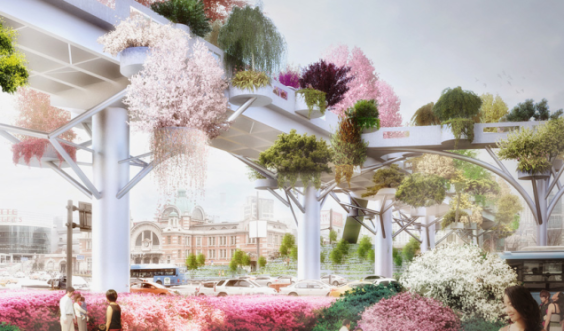 This Crumbling Highway Overpass Is Becoming a Sky Garden
This Crumbling Highway Overpass Is Becoming a Sky Garden
If you live in a post-industrial city, odds are good that it’s got its share of abandoned, blighted transit infrastructure. Some cities demolish it, some cities let it fester, and other cities repurpose it. In Seoul, they’re choosing the latter.
Seoul has spent the past year deciding how to renovate a long stretch of highway overpass that cuts directly through part of the city, right next to the city’s Central Station. The 3,000-foot-long stretch of highway was built in the 1970s as the city boomed—like so many other elevated urban highways, cough cough, BQE—but sank into disrepair over the years. In 2006, the city had it shut down over concerns about its structural integrity—and it seemed it would finally be razed.
13 May
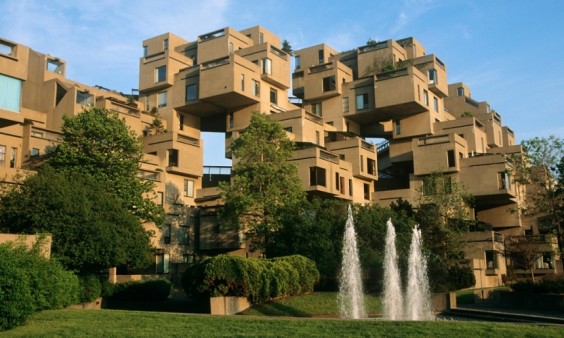
Habitat 67, Montreal’s ‘failed dream’ – a history of cities in 50 buildings, day 35
The pilot project of Moshe Safdie’s mission to reinvent apartment living became mired in controversy – yet it remains a functioning icon of 1960s utopianism, and one of that period’s most important buildings
(The Guardian) Habitat 67 echoes a little known post-war Japanese architectural movement called Metabolism, whose proponents believed buildings should be designed as living, organic, interconnected webs of prefabricated cells. Perhaps the most famous Metabolist incarnation is Tokyo’s Nakagin Capsule Tower, another pile of concrete cubes dotted with porthole-like windows, erected in 1972. The influence of Le Corbusier, especially the French master’s love affair with concrete, on Habitat 67 is also clear. But Safdie set his own course, attempting to balance cold geometry against living, breathing nature.
It was while travelling across North America as a student that Safdie surveyed grim apartment high-rises and unsustainable suburban sprawl. He returned home to Montreal with a mission: to “reinvent the apartment building”. He longed to create, as he put it in a 2014 Ted Talk, “a building which gives the qualities of a house to each unit – Habitat would be all about gardens, contact with nature, streets instead of corridors” (each cube has access to a roof garden built atop an adjacent cube).
It may never have achieved affordability but the building, just two years shy of its 50th birthday, remains a potent symbol. In 2009, the Quebec government gave it heritage status, recognising that despite the controversies and maintenance issues, Habitat represents much more than a yuppified ghost of 1960s idealism.
“Safdie’s expression ‘For everyone a garden’ is still an incredible idea,” says Riar. “At such a young age, he realised that suburbs are not necessarily bad, but city living is important. He asked: if people had more space and light, would they stay in the city? It’s a very noble idea.”
8 May
Cars, Pedestrians, and the Struggle for the Future of Downtowns
30 April
Have we really reached ‘peak car’?
Vehicle traffic grew at a fearsome rate worldwide for decades … until 2007. Then came the perfect storm of an economic collapse, a digital revolution and major changes to urban lifestyles. But is this just a blip?
(The Guardian) [David Metz, formerly chief scientist of the UK Department for Transport and author of Peak Car: The Future of Travel] attributes this mostly to the diminishing marginal value of additional car travel now that we can move fast and far on mature transport infrastructure, like buses and trains. The amount of time people are willing to travel has been relatively constant throughout most of history: roughly an hour a day. As technology enabled us to travel faster, we were able to travel further within that travel-time budget, which vastly expanded the circle of possibilities open to us. Now that modern transport, especially roads and modern automobiles, is ubiquitously available, we have almost everything we need within our “travel budget”. Therefore, we gain little from more driving.
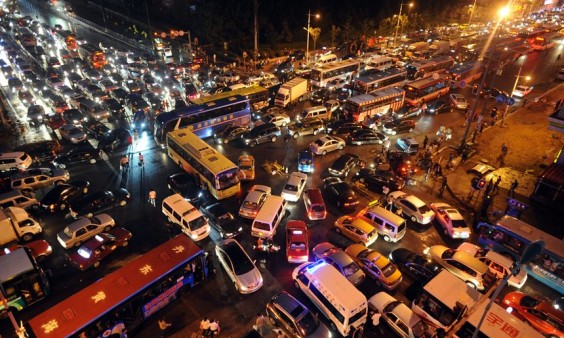
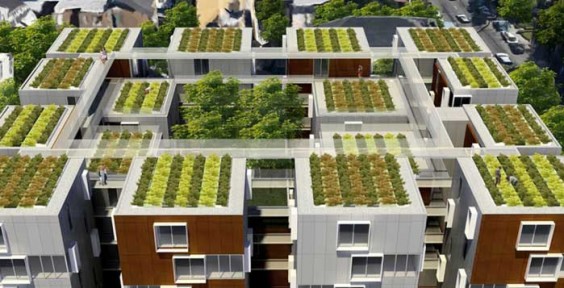




One Comment on "Cities & sustainability"
Great post. I was checking continuously this weblog and I’m inspired!
Very useful info specifically the closing phase
🙂 I handle such information a lot. I was seeking this certain information for a long time.
Thanks and best of luck.